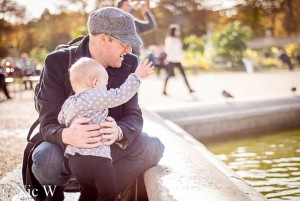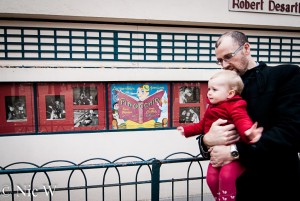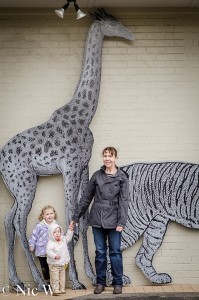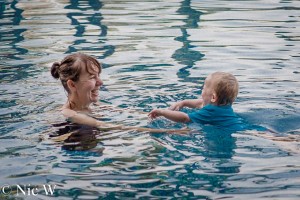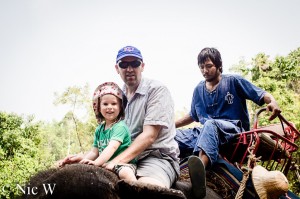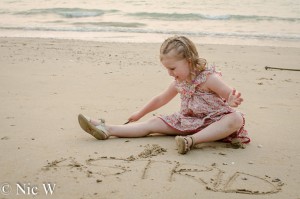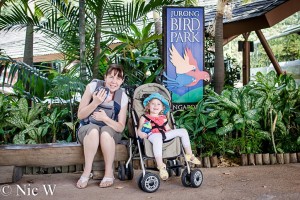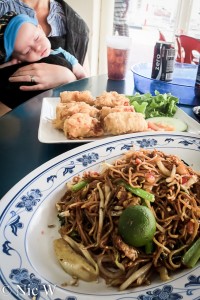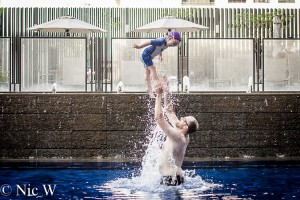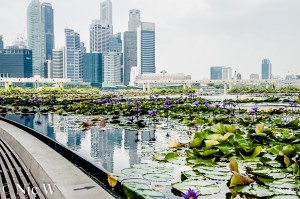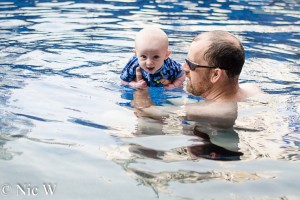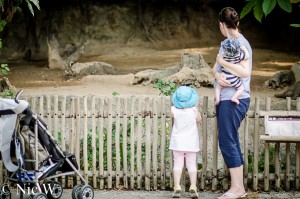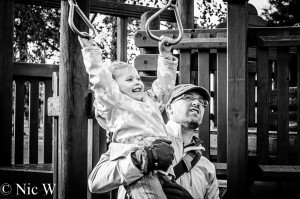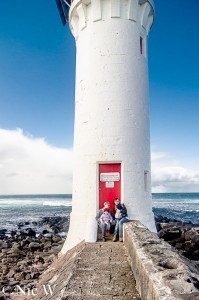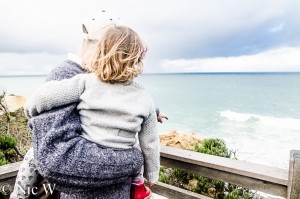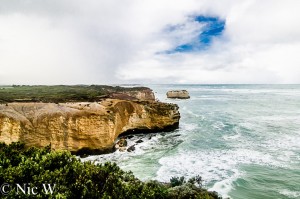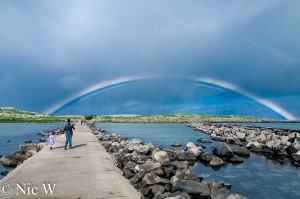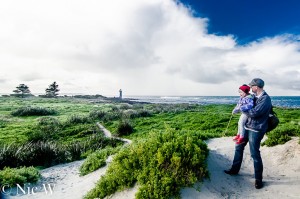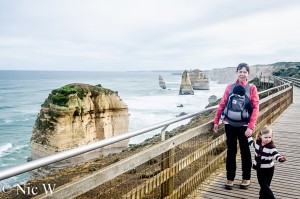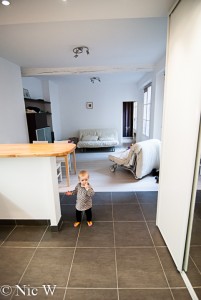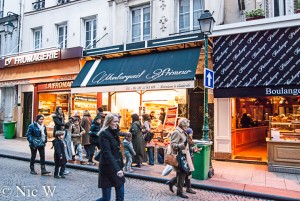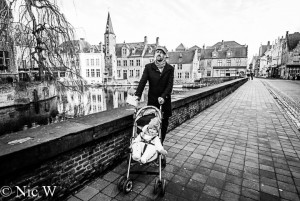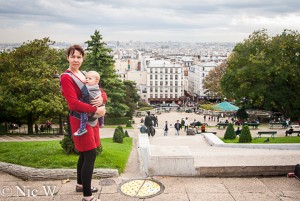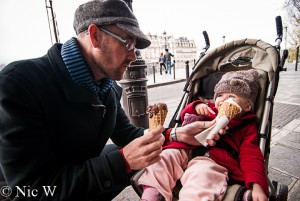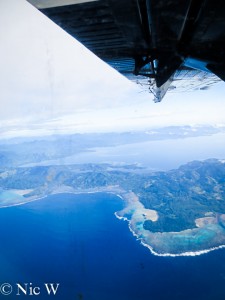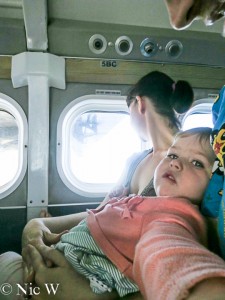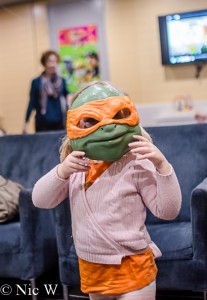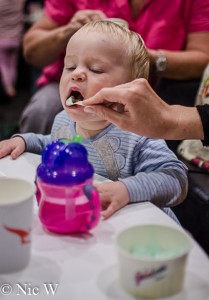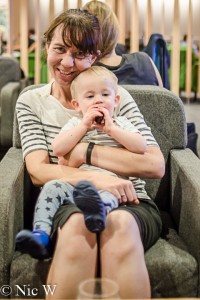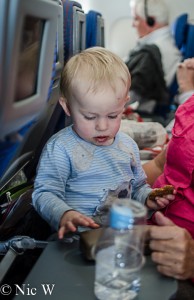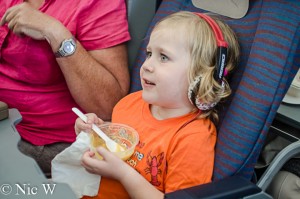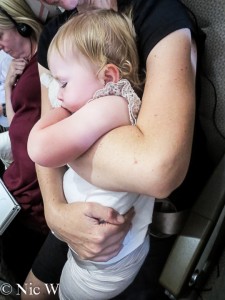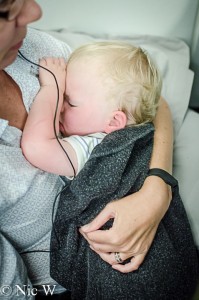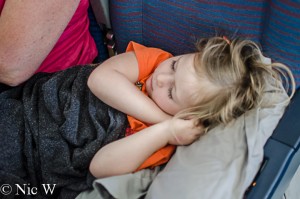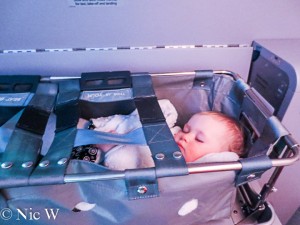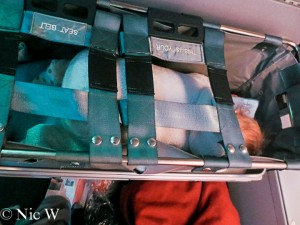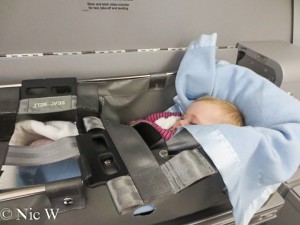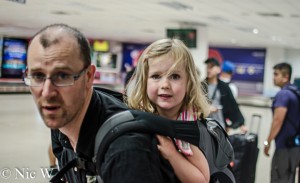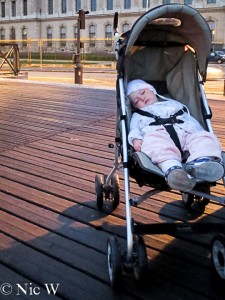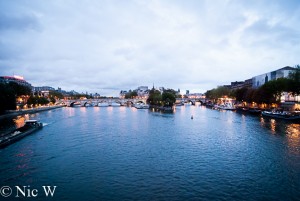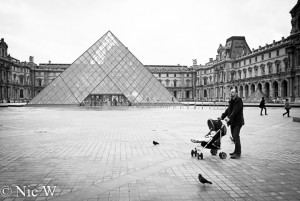With all the travel planning we have been doing lately, I’ve been meaning to write a post or two with tips, hints and advice for those travelling with kids. I have quite a few friends with upcoming trips, so I thought it might be a useful reference for them and any other readers out there planning travel…….. I also sometimes need reminding of things myself, and can definitely still learn a thing or two, so would love some tips from other travelers!
Our experience is with babies, toddlers and young children – we have obviously not yet traveled with older kids or teenagers. Those with experience travelling with older kids, please share your advice and prepare us for the future!
Both Anto and I did a fair bit of travelling growing up, and before we had kids. It’s a whole different ball game though when you have small people tagging along with you. The extra luggage, the disruptions to routine, trying to keep them entertained, tired babies, cranky toddlers, and the vomit (there is always vomit, at least in our house). It is lots of fun though, seeing how excited they get by new places, people and food……. and when you just ‘have’ to do things to keep kids entertained you get to do lots of fun things you otherwise probably wouldn’t do!
We don’t travel as much as some people (or as much as we’d like to) but in her 4 years Astrid has racked up nearly 50 flights, 11 countries and countless train and car trips. Soren at 22 months is lagging behind a bit with almost 20 flights and only 3 countries. He has done alright on the domestic travel front though! Our upcoming European trip is going to involve a lot more flying, more countries and many more train trips, and hopefully a few more passport stamps.
This post will cover how we approach planning our trips, and tips on flying with kids and dealing with jet lag. In later posts I’ll talk about train travel with kids, car travel with kids, accommodation, packing, food and how to prepare for the weather.
Travel planning
Since having kids, we’ve undertaken a variety of different ‘styles’ of trips. No two were planned the same way. So, I’ll run through the main sorts of trips, to give you and idea of different ways you can plan. There is no right or wrong way to travel plan, we plan trips differently depending on the type of trip, the length of trip, budget and what we are hoping to achieve. Our upcoming trip to Europe is probably our most ambitious. We used our experiences on previous trips to help plan the upcoming Europe trip, and to know what is feasible with 2 small children.
Short domestic trips
Domestic trips to visit family and friends, and visits to Sydney, Melbourne and Brisbane we don’t do much planning other than sorting out flights, transport and accommodation. We keep our itinerary fairly free and plan activities and catch-ups depending on the weather, how we feel and what people have on. We do try to book flights in advance, to get cheaper flights (when possible).
Tropical Resort/dive holidays
We’ve done a few resort/beach style holidays (Phuket, Koh Samui and Fiji). We again sort out flights and accommodation and transfers, and don’t plan too much else until we arrive. If most of the time is going to be spent at a resort, it’s easy to book dives, snorkels and tours once we are there and know what the weather is like and how we are all feeling.
As most of our time is spent around the pool or beach this style of holiday works well with small children. You can have plenty of swimming time between naps and the kids are usually happy to spend hours in the pool or on the beach.
It is generally really hot in the middle of the day (and the UV index is also at it’s highest) so this is an ideal time for a rest or nap, both for the kids and the adults.
We try and pick up hotel and flight deals when they come on sale, so often book these well in advance.
Singapore
Longer trips and trips where we want to fit more activities in, we plan a little more. Our Singapore trip, that we did in March 2014, was organised only a week before we flew out, but was easy to organise quickly. Anto and I had been to Singapore on our honeymoon, so had a fairly good idea of what we wanted to do and see, and how long each activity would take. We based the number of days on what activities we wanted to do (including things we didn’t see previously but had been recommended) and of course budget and work commitments.
On that trip Soren was 4 months old and Astrid 2 years 9 months. We knew with the heat and humidity and very young children we had to limit what we could achieve in one day. We tended to do 1 big activity a day like the bird park, zoo, Sentosa Island, Marina Bay etc, and leave the rest of the day free for naps, swimming and keeping cool in the air conditioning. We didn’t plan which activities were on which days prior to arriving or prebook any tickets. We had a rough plan in our head of what order we would like to do things in, and timings, but decided each day what the best plan of attack for the next day would be.
Soren was having 3 sleeps per day at 4 months, and Astrid a lunch time nap, so we would be down in the restaurant early for breakfast and then we would usually let Soren nap in the room while we got organised for the day, or Anto and Astrid dropped off and collected washing. If we had a long MRT or bus ride that morning we’d time it so he would sleep in the ergo while travelling. It was often more pleasant in afternoon for walking around (lower humidity) so the morning would be swimming, a water park or shopping, lunch and a nap for the kids, and then heading out for the afternoon to walk around the zoo etc. Soren would again nap in the ergo or stroller for his afternoon nap and we’d be back by dinner. Some days if it wasn’t too hot, we would do our activity in the morning and swim and relax in the afternoon. By having only loose plans, we could time our activities to the weather and how tired the kids were, and we still fitted in all our planned activities.
Great Ocean Road trip
This trip was in July 2014, when Astrid was 3 years old and Soren 9 months. This is the only really long road trip we have done with kids. As we were covering a large number of kilometres (around 3000km all up) and stopping in a several spots along the way, we planned out which town we wanted to stay in or visit for sightseeing purposes, and worked out the driving time between each. Breaking the drives down to small chunks each day, when possible.
We had a few towns and cities where we were catching up with friends – on the way from Canberra, South through Ballarat and Warrnammbool to the start of the Great Ocean Road, so planned overnight stops around that. Our time touring the Great Ocean Road was broken into smaller drives to allow us time to see the scenic coast line, stop at lookouts along the way, and visit towns of interest.
Driving with kids is not the most fun, so aside from a couple of long stretches either side of Canberra, (on the way down and home) where there isn’t much to do, most of our days involved only a couple of hours in the car and the option for lots of stops.
We again only organised this trip a week or so before leaving. We did pre-book our accommodation, and tee up visits with friends. We had worked out which scenic stops we wanted to do, and activities in towns we wanted to stop in. Working out the driving times for each segment of the trip let us plan the best times of day to leave, and gave us plenty of time to do the activities we had planned.
Europe – our 2012 trip
This was our first big overseas trips with children (well child, Astrid was 15-17 months during this trip). We thought it would be nice to base ourselves in one place for most of the 2 month trip and do smaller side-trips to other locations. We were keen to explore Paris and the region, so rented an apartment in the 2nd arrondissement in Paris as our base for all but the last week of our trip.
In the planning stages of our trip we worked out which regions and countries we wanted to visit outside of Paris, what activities we wanted to do in each, and worked out the timing and cost for each, and how best to get there (fly or train). We then planned the best time to do each. We allowed the first two weeks in Paris, to get over jet-lag, get our bearings, figure out how to use the metro and the trains, and do some exploring of Paris. We then scheduled our other trips at regular intervals. A 5 day/4 night trip to Switzerland, a 3 day/2 night trip to Brussels and Amsterdam and the final week of our trip – a trip to Brugges and Ghent in Belgium, then flying back to London (via Brussels) for a couple of days on the way home. These 3 trips were all booked and paid for (accommodation, flights and trains) before we departed.
We had also ear-marked some shorter trips – a trip to Luxembourg (which we ended up doing as a day trip); a trip to Mont St Michel on the West coast of France (this was 2 days/1 night); and, a trip to the Loire Valley (again a day trip). All of these we picked dates for once we were already in Paris, working around what we were doing, the weather and how we felt. It was very much a case of ‘where will we go this week’. Then we would book the trains and accommodation and off we’d go.
We also left the option open to do other trips during our Paris stay. We ended up doing a 4 day/3 night trip to Sweden, both to explore Sweden and catch-up with friends. This was organised on fairly short-notice while we were already in Paris, booking flights and trains a few days before we left. We stayed with our friends while in Sweden, so saved on accommodation.
For the trips out of Paris, we researched what activities we wanted to do, worked out timings and transfers before embarking on the trip. As we only had a short time in each city and country on these trips we had developed a good list of what we wanted to do, and what order to do it in, using tripadvisor and google maps extensively. A few times the weather disrupted our plans, but on the bright side it gives us an excuse to go back and visit again on another trip! These travel days were fairly intense, we’d walk all day and Astrid would generally nap in the carrier. Even with a toddler we still managed to see most of what we wanted in a day, and still have her back at our hotel for her normal bed time.
The time we spent in Paris was much less planned. We had the list of ‘must-see’ tourist spots like the Louvre, the Eiffel Tower, the Arc de Triomphe etc, but we didn’t plan what we were doing on which day. We usually had several days, or a week at a time, in Paris between other trips. So, we’d decide what we felt like doing that day, dependent on the weather and how we felt. We worked our way through our list of activities over the two months. We also had a good guide book which covered exploring Paris with kids, and had lots of kid-friendly activities to check out.
Astrid usually had a lunch time nap, so we often picked somewhere to go in the morning and then headed back to our apartment for nap time then did an afternoon activity. Some days she fell asleep in the stroller, and we would just keep walking around while she slept. It was a great way to see lots of Paris on foot. Most days our planned ‘activities’ were picking an area and either catching the metro or walking there and then exploring on foot for a couple of hours. This allowed us to discover new parks and patisseries on the way. Even with over 5 weeks in Paris, we didn’t come close to exploring the whole city. We certainly ticked off the major tourist attractions, but there was still plenty of areas we didn’t get to.
The apartment gave us a great base to explore Paris at our leisure, and cooking and washing facilities. It also meant we weren’t constantly on the move and had somewhere to leave the bulk of our luggage, when doing shorter trips. It was a great way to plan a holiday, when you really want to explore one area, and have a more relaxed itinerary with small kids. The downsides would be that we doubled up on accommodation some of the time – paying for hotels while on trips away from the apartment. This was well and truly offset by the savings of renting an apartment monthly so wasn’t a massive issue. We also probably didn’t see as many cities and countries as you could in a 2 month trip, if you were moving around more. This was offset by getting to spend more time in Paris, which we loved, and having a more relaxed time with our toddler.
Europe – our 2015/6 trip
Since our 2012 trip we’ve been hanging out to return to Europe for another big trip. In 2012 we returned in the second week of December, just when Christmas festivities were kicking off, and we vowed we would have to return for a European Christmas one day.
This upcoming trip primarily came about as we had a plan to catch up with our Swedish friends, and December was a time that suited both parties for leave from work and school holidays. Astrid is starting school in February so we planned our trip around the school holidays and her break between preschool and starting school.
We decided that rather than base ourselves in one place we will move around a little more this time. Of course we now have 2 kids, but we found the trains cheap and efficient last time so started formulating an itinerary based around train travel. We had a set of dates we needed to be in Sweden to catch-up with our friends, so worked around those and looked at what else we wanted to do with our time. Our ‘wish-list’ of European cities to visit is longer than time or budget would allow, so it was a matter of picking what things made sense to do on this trip.
Flight-wise and cost-wise it made sense to fly into Copenhagen, prior to our visit to Sweden, and we knew we wanted to spend some time back in Paris, so booked our return flight out of Paris. The flights were 7 weeks apart, so we just needed to fill in the middle bit! With endless possibilities, we came up with a draft itinerary by looking at a map and seeing what places we might want to visit and what looked like a sensible route to take. We then researched train and flight connections and what activities we wanted to do in each city. We roughly assigned a number of days/nights to different cities based on our initial impressions.
As we were traveling over Christmas and New Year we had to figure out where we wanted to be for both Christmas and New Year, and see if we needed to modify our itinerary. We then went back and looked in detail at each city, planning exactly what activities we might want to do and how long they were likely to take. This, plus working out the timing for the train and flight connections let us refine the itinerary further. Most of this research was based on tripadvisor and travel blogs. As we did more research on each city, we realised we needed more time in some places and less in others. Sometimes the train connections meant that it made sense to do some places as a day trip or a transit day between other cities, rather than spend a night there, like we had originally planned. We also cut some places out of the itinerary and added others in, based on what things we had planned in other sections of the trip. For example the first few weeks of the trip were very castle and palace heavy, so we added in more fun snow-based activities for the second half, leaving out some cities that were going to be more of the same castle/palace type activities.
Once we finalised the number of days and nights we wanted in each location, and picked the appropriate flight or train time to ensure we had enough time in each place excluding travel, we started booking accommodation. Apartments where there were suitable and economical options, and hotel rooms when there weren’t. Once all the accommodation was booked, we booked the remaining flights within Europe. We are about to start booking the train legs, as bookings only open 90 days out from the date of travel. We have also booked a few bike tours and are looking at what other activities need to be pre-booked. We are still costing which cities it makes sense to buy the city/tourist cards for, and what savings they will offer. This is helping refine the day by day itinerary for each city.
This trip will involve much more moving around than our previous Europe trip. We have still planned our activities taking the kids into account. We know what activities they will likely enjoy (zoos, parks, ice skating etc) and which ones they tire of quickly (museums!) so have planned with that in mind. They will happily walk around a castle for a short time, but 3 or 4 in a row is not going to happen. Something ‘boring’ followed by a run in a park or a visit to the zoo is a much better balance. Both our kids like being out and about and will sleep in a stroller or carrier when they are tired. We have tried to balance out our itinerary, with some days and cities that will be less rushed, so we have time to rest and let them catch-up on sleep (or visit extra parks). We have also planned train trips, where practical, to be at rest time, or allow a break on busy days.
It will certainly be a challenge to visit 19 different cities over 7 weeks, with 2 small kids in tow! But, I think we have a fair idea of what challenges are in store. I will be blogging about our trip so, you can follow along and see how we go. I’m sure I’ll have a good list of do’s and don’ts after the trip….Do drink more wine? Don’t even attempt this?
Flying with babies and kids
It’s a concept that strikes fear into the hearts of even the most seasoned traveler, but it isn’t as bad as you think (at least most of the time!). Every long haul flight has me wondering why we are doing this yet again, and I’d rather be stabbing myself in the eye with the economy class plastic forks than enduring several more hours trapped on a plane with my cranky children.
When flying with kids, it pays to remember:
* It does eventually end.
* No one knows you, they are never going to see you again, and they probably aren’t even paying to you or your kids anyway (headphones drown out a lot of the noise).
* Anyone who has kids is usually sympathetic.
* The hosties will normally bend over backwards to keep you and your children happy and quiet.
* It’s only a day (or day and a half) out of a whole trip, and it’s worth it to get there.
* Wine and chocolate help (for you). Chocolate and biscuits for the kids. All the biscuits, feed them the whole packet if it helps!
Flight timing
For short and/or domestic flights, try and time the flights for rest or sleep times when possible. Obviously you have to fit in with your travel plans and you want the cheapest flights possible, but when all things are equal we pick a time when the kids are likely to rest. This is especially useful for babies as flights are much easier with them asleep. The motion of the plane often sends them off to sleep, especially if you are feeding them on take-off and landing to help with their ears equalising.
For longer and long-haul flights we try to pick overnight flights if possible. Time passes much more quickly when they are sleeping and it’s less stressful all around. Multi-leg journeys and long-haul of over 14 hours you are going to end up with times they are awake (probably lots of it), so try and make the lay-overs either 2-3 hours so you have time for a run around and time to stretch the legs, or long-enough that you can get out of the airport for an activity or get a transit hotel for some sleep. We normally go for the short lay-over and get it all over and done with.
Before the flight
Make sure you have everything packed you will need onboard (see below). Once you have checked in and cleared immigration, head somewhere that the kids can play and run around. We have a lounge membership for Qantas, so use Qantas club when possible. Many have ‘kids zones’ with space for the kids to play and be noisy. There is also plenty of food options to make sure they are fed and watered. If you don’t have lounge access (and we often fly on airlines that we don’t) find an empty gate near your boarding gate, or a quiet spot in your gate and let them play and have a run around. It’s fun to watch planes take-off and land, and you can go for walks and check out the shops for entertainment.
Make sure everyone has had something to eat and drink. Short flights you will often only get a snack, and it’s sometimes not kid/baby friendly. Longer flights you will get one or two meals (and some snacks), depending on the length of the flight. The first meal is usually 1-2 hours after takeoff, but you are often sitting on the plane for quite awhile before actually taking off. If it’s an evening or night flight the ‘dinner’ may be well past the kids bedtime and you don’t want them staying up for it, so having them pre-fed is ideal and hopefully they will sleep sooner.
Do a nappy change and/or toilet visit just before boarding, as it’s a lot easier than on the plane. Long flights will require nappy changes and toilet visits but if you can avoid it during the boarding and take-off process, when you really can’t be out of your seat, it will be much easier.
Make sure you have booked either an infant, toddler meal or child meal (as appropriate) for long flights, and check it prior to check-in. Don’t assume that because you have a ticket for an infant or child a suitable meal will be provided. Some airlines will only provide them when specifically ordered. We have been caught out by this in the past, and it sucks to be on a long-flight without suitable food for your small child. Our kids eat pretty much anything, but without fail the meals provided will be the one thing they hate!
What to pack
Snacks, lots of them! We recently become a bit lax on this front, and it bit us in the bottom, hard! Quite often you’ll have a bag full of snacks and not touch them. Then you get a flight when suitable meals aren’t provided and the hosties have no suitable snacks and you’ll be very glad you have your own. Anything your kids eat is good, but biscuits are usually a winner, packets of chips, fruit (apples, bananas, mandarins), museli bars, sultanas or other dried fruit. If your child is old enough some lollies or a lollipop to suck on during take-off and landing is really useful to help with their ears. We avoid anything really messy (chocolate hands are annoying) or dairy based as it can make them puke.
Baby wipes – lots of them! They will come in handy for grubby hands, spills and nappy changes and vomit. They also get marks off your own clothes.
Water and appropriate water bottles. Water will be handed out on the plane, but kids often can’t wait that long, and they usually spill the little bottles or cups they give you. I take their own water bottle and make sure it is filled before boarding. Even though there are fluids restrictions on international flights, water for infants and children is allowed so you will be able to take it on if traveling with a child. Be aware that the water bottles/sippy cups often leak as the cabin pressure changes so loosen the lids to depressurise and re-tighten before giving them to the kids or you will all end up soaked from the water spraying out the top as the open the spouts. Yes, this happens to us on every flight!
Formula and/or bottles if you have a baby that is being formula fed or you want to give formula on the flight. Make sure you work out how many feeds your are likely to need, and allow at least one or two extra. It is possible to wash out bottles on a long flight, but not easy so take enough bottles. You can prefill with sterilised water and add the formula during the flight and ask the hosties to heat it for you, or you can ask them for boiling water to add your formula too. Either method takes time for it to heat/cool and if it’s the middle of a meal service be prepared to wait awhile. If you are going to do a feed in the first couple of hours of a flight (a good idea on take-off) take a bottle made up and preheated if possible. You can take premade formula onto an international flight if traveling with an infant. You may be asked to prove it’s formula but this never actually happened to us.
If you are breastfeeding, you have the bonus of not needing to worry about bottles and formula, and this is significantly easier!!! Hosties will provide you with pillows to make feeding easier and I recommend grabbing a few to help prop the baby up and protect your arms from the hard plastic arm rests (this goes for anyone with a baby/toddler sleeping on them!). As I have explained previously on this blog, I had supply issues with both my babies, so fed both of them with the aid of a supply line for most feeds (filled with formula). This meant I had to deal with making up formula on the flight and taping the supply line on during feeds. Even doing this, I managed to feed them during flights fairly discreetly and no one ever batted an eye at me feeding. I also saw many mothers breastfeeding during flights, so there is no need to feel uncomfortable or anxious about it. You can bring a cover to feed under if you wish, but it’s certainly not necessary. Most people will not be able to see what you are doing or even notice, unless they are directly next to you on the plane. Most people won’t care as long as your baby is happy (which usually results in quiet).
Take any prescription medications required for any family members (and a doctors letter or prescription if necessary). We also take infant paracetamol and ibuprofen on board too, in case of teething pain, sore ears or generally unwell kids. Check the regulations of countries you are traveling to regarding what medications you can bring in. In particular, some Asian countries are strict on things we can buy over the counter here.
Take enough nappies and changes of clothes for the flight. Preferably take more than you think you will need. I don’t know about you but my kids are really grubby. Even on a good day they will be covered in food and spill water all over themselves. The amount of clothes we take onboard is directly proportional to the length of time I’m willing to have myself or my children sit in wet, vomited on clothes. Have I mentioned they like to vomit, a lot? For short (1 or 2 hour) flights I often don’t worry about changes of clothes for the adults and just take a spare pair of pants for the kids in case of a nappy leak or spilt drink. For longer flights, and long-haul we take an onboard bag with a couple of full sets of clothes for every person. This allows for a change of clothes for the inevitable food and drink spills and a change of clothes at the mid-way point of a long-haul flight during a layover. If your bags go missing you also have at least some clothes on you. It’s a good idea to take at least 1 extra pair of shoes each onboard (even if they are thongs) in case you end up with vomit in your shoes. Been there, done that, glad to have to extra shoes! If you pack each persons clothes into separate ziploc bags it makes them easy to find quickly, keeps them together, and gives you something to put the gross/wet stuff back into.
Pack a small number of toys or games for babies and kids. Airlines usually give out entertainment packs with colouring pencils and a colouring book. Under 2 year olds don’t find this that exciting though! A small rattle or chew toy (like sophie the giraffe) is great for babies, a little etch-sketch or some hand puppets work well for toddlers. Preschoolers and school age kids are usually pretty happy with watching TV or playing games on the onboard entertainment system, but check what your flight has available. Not all planes have onboard entertainment, and it sucks to then have to entertain a bored 3 year old for 3 hours with nothing but a flight safety card (been there done that too!). Some small books or an i-pad with games in flight mode can be useful. Really both our kids have been entertained for hours with taking lids on and off drink bottles or playing with a pen. It is handy to have something stashed in your bag to keep them entertained. Things that are small, quiet and not precious (in case they are lost) are ideal.
If the flight is overnight or a sleep time, it is a good idea to take a comforter or special toy if your kids like to sleep with one. It helps them settle in a really unfamiliar environment. If you have a baby or toddler that sleeps in a sleeping bag, or with a special blanket take it onboard too.
Take your own child-sized headphones for kids who will be using the inflight entertainment. Most airline issued headphones are too big for kids and you spend the whole flight adjusting them. You can buy good quality kid-sized headphones quite cheaply (also a good idea to buy and adaptor so they can be used on flights), and your kids will be comfy and able to watch endless hours of TV and leave you in peace!
During the flight
If you are changing timezones try and get yourself and the kids onto your destination time zone as soon as possible. That might mean keeping them awake a little longer or waking them up a little earlier. Happy, quiet kids are the goal so definitely let them sleep if they need to, or are cranky, but if all is going well try to push into the new timezone when possible.
If you aren’t lucky enough to have your baby or toddler fall asleep on take-off or shortly after (it does happen to us sometimes), then you sometimes need to employ whatever tricks and techniques possible to get them to sleep. Feeding to sleep often works with little ones, or walking up and down the aisle (when the seatbelt sign is off). If they are particularly grumpy you can sometimes pop them in a sling or ergo, to contain the wriggles, and walk the aisles. Again this is only for when the seatbelt sign is off. Sometimes nothing works! They will eventually sleep, you just have to ride it out. It is usually more stressful for you than anyone else on the plane, and at any given time there are at least 10 babies screaming on your average flight (totally made up statistic), so yours won’t be the only one!
Astrid is a regular flier, and now old enough to negotiate with. We can usually tell her when sleep time is and negotiate a small amount of TV or food before she has to lie down and go to sleep. She normally sleeps pretty well on flights, once she gets over her excitement. Soren is still not that interested in TV and at the wiggly age. He was great as a baby, not so much fun now. Having flown with kids between newborn and 4 years, we’ve found that under 6 months is the easiest, and walking age until they are old enough to be entertained by TV the worst age.
When your kid(s) do sleep, try and rest or sleep too. This is really hard if it is not your bedtime or you aren’t tired. But, they will inevitably wake up after not too long and if you’ve had no sleep yourself on really long flight, it’s hard to function, let alone parent. If there are at least 2 adults traveling with the kids you can take it in turns to sleep, but it’s much harder when traveling alone with kids.
During a flight I’m pretty much an ‘anything goes’ person. While normally I wouldn’t be a fan of a 2 year old watching 8 straight hours of TV or eating half a packet of biscuits, it if keeps them happy, let them do it. The exception is annoying other passengers. No pulling on or kicking other peoples seats is tolerated, but some crying or whinging is not the end of the world and most passengers understand that flying is hard on babies and kids.
Other flying tips
Bassinets are usually allocated in order of youngest baby to oldest. Different model planes have different numbers of bassinets, and while you can request one when flying with an infant, it usually won’t be confirmed until check-in. If you are traveling with a young baby, you have a good chance of getting one. It does depend on the number of babies on your flight, flying to Fiji the planes are half full of babies and your chances are slim (unless you have a newborn), non-tourist routes the chances are higher. You do need to check the height and weight limits on the bassinets. They differ greatly between different airlines and plane models.
If your baby is too big or long for the bassinet, or you don’t think they will sleep in it, you are better off not being in the bulkhead row (where the bassinets are usually located) as in these rows the seat arms do not usually lift, making it harder to rest across multiple seats or sleep with a baby in your arms. Young babies usually fit well in the bassinets and if you can get them to sleep in them it is a more comfortable flight for all of you. Some have seatbelt attachments that go over the top of the bassinet and you can leave the baby in when the seatbelt sign is on (not during take-off and landing though). Others do not have this function and every time the seatbelt sign goes on you have to take your baby out and put them back on you with their infant seatbelt attached. This is extremely frustrating when you have just gotten them to sleep!
When your baby or kids are sleeping, make sure their seatbelts are on, and visible to the flight crew (if possible do them up over the blankets). This way they won’t have to be woken to check on their seatbelt every time the light goes on (which happens a lot on a turbulent flight).
If there are spare seats, and you are traveling with an infant on your lap the crew often try to reseat people after take-off to give you more space. You can’t guarantee it, but it’s nice when it happens. The bulkhead seats give you more leg room, and it can be handy to have the extra space for kids to play in when in flight, but the arm rests not moving is a negative at times.
Meals can often be at odd times. Usually not when your kids want to eat. This is where the snacks come in handy! If your kids are asleep (or not hungry) at meal time, you can ask the crew to hold their meal. They can normally only be held for an hour or so and then have to be thrown out due to food safety regulations. It then may be hours until the next meal service. The crew often have snacks, but they aren’t always baby/toddler appropriate and they sometimes run out. Make sure you have your own. The first meal is usually an hour or two after take-off, but if there is turbulence or a delay this can mean you are getting served dinner many hours into a flight. The last meal is normally an hour or so before descent commences, it is often breakfast at 4am! The lights will be off in the cabin, everyone will be peacefully sleeping, and all of a sudden the cabin will be lit up and food will be being dispensed. Your kids may not appreciate being woken after only a few hours sleep and asked to eat. It’s then a long time until you actually get on the ground (and you may have another flight to go still).
If you need to help babies and kids with their meals, ask the crew to hold yours while you help feed them, or alternate between the parents. There is nothing worse than trying to juggle everyone’s meals and balance a baby or toddler on your lap. It’s a recipe for mess!
Dress yourself and the kids in comfy clothes and layers. The temperature varies quite a lot. Most airlines will give you blankets but it’s useful to have a few layers to add or take-off as needed. We often fly from cold weather here to somewhere warm (or vice versa) and you don’t want to carry a heap of clothes with you that won’t get used during your trip, so layers are a good answer.
After your flight
Airports involve a lot of walking! It’s handy to have a carrier or sling to help carry the little ones through airports. Astrid is four, but we still often put her in the ergo through airports. Kids can be tired after long flights and there are crowds of people walking in lots of directions, keeping kids contained is useful. There can also be large distances between gates. On our recent trip to Thailand, I tracked over 5km of walking between getting off one flight and getting to our gate for our next flight at Bangkok airport. That is a lot of walking for little legs. When Soren was smaller I often popped him in a sling and Astrid in the ergo. We now have 2 ergos, so I can carry both at once, or one on each of us, giving us spare hands for luggage.
At some airports, when you are traveling with small children you will be fast-tracked through immigration and/or customs. It’s awesome when it happens! Other times, you line up for seemingly hours, with tired and very cranky kids. This bit is definitely not fun, but if you can keep everyone calm and relatively happy (bribery and snacks), it’s luggage collection and on your way. With all the waiting around at immigration and collecting luggage, this is also a good time to have kids in carriers, especially if it’s the middle of the night and they want to sleep.
Jet lag
Unfortunately jet-lag is an annoying by-product of changing time zones. When traveling from Australia (unless heading to New Zealand) you are most likely going into a timezone behind your normal one. This inevitably results in kids waking up very early on your first few days away. By very early, I mean like 3am! Not fun for anyone, especially if you are in a resort or hotel where you can’t make much noise or it’s pitch dark and freezing cold outside.
Small children that are wide-awake in the middle of the night because their body has told them it’s morning, will not be reasoned with. Explaining it is not yet morning and it’s sleep time still, is unlikely to work (feel free to try though!). The best idea is to anticipate the early wake up and embrace it …… then drink coffee for the rest of the day!
How tired and how jet lagged you are will depend on your transit time, how much rest you got and what time you arrive. If you arrive at your destination before dark and your kids bedtime, and have found your accommodation and deposited your bags, go for a walk and explore. Let the kids run around and burn off some energy, and get some sunlight to reset your body clocks.
If you are desperate for some sleep (and it’s kid nap time), even if it’s still daytime at your destination, then have a nap but set your alarm for 1-2 hours and then get up when the alarm goes off. Your body will think it’s night time and you will feel like death, but you have to get up and get moving so you can sleep that night.
If you arrive late in the evening or the middle of the night, make sure you have all eaten a decent dinner, have a shower and then get some sleep. A few times when we have had late arrivals into destinations, after long travel times, we have all had a decent sleep and mostly woken up in the right time zone.
Usually, you don’t get that lucky though. Despite the fact that your kids (and you) have had less than half your normal amount of sleep, those pesky body clocks are likely to wake you early. It’s a good idea to check what time the hotel or nearby restaurants open for breakfast, so you know how long until you can get food. It is also a very good idea to have snacks available to tide you over until you can obtain food. A 3 or 4 hour wait for breakfast with hungry children is torture, so a stash of museli bars, biscuits and fruit will help. This is particularly important if you are in a resort with no other food options nearby. Make sure you take sufficient snacks with you for the travel leg and to get you through the first morning and you can do some shopping.
Once you’ve had some food (be it hotel snacks or an actual breakfast) then go outside for a walk and and explore. It doesn’t matter how cold or dark it is, outside is your friend! We’ve been those people with an awake toddler at 4am, when the sun won’t be up for another 4.5 hours and it’s 2 degrees and raining. Trust me, outside is still your friend! Most city areas are fine to walk around in the dark as long as you stick to well lit areas and aren’t in a dodgy neighbourhood. It can be fun walking around in the quiet and watching the sun rise, before all the tourists are out and about. If you are traveling in the Summer months, it may be light early so getting out isn’t too hard.
We did a lot of exploring of Paris in the early hours of the morning and got to see all the sights without crowds and got some amazing photos. As a bonus, after awhile walking around Astrid would often fall back to sleep in the stroller, and we could have a coffee before heading back to our apartment for breakfast and the days activities.
If you are in a resort, check the rules on pool usage. Once the pools are open for the day, go for an early swim to keep the kids entertained and tire them out. You don’t want to wake up other hotel guests but if you keep the noise down and abide by the opening hours it is a good way to fill in time until breakfast.
The first day or two you will all be tired from the long travel legs and time zone changes. Try and get into your destination time zone as quickly as possible by making sure you’ve changed all your watches, clocks and phones to the new time zone and eat meals and plan naps as much as possible for the new time zone. Kids might need a longer and/or earlier nap(s) than usual on the first day or two, and the adults can often do with a nap too. Make sure you don’t sleep all day though and set alarms if you need to. The kids will sometimes nap while out and about in the stroller or ergo which helps them catch up on sleep.
Try and get back to a normal bed time and bedtime routine on the first full day, so that you can hopefully all start waking up the correct time as soon as possible and not feel too tired. We always assume the day we arrive and the first full day will be jet lag affected and don’t plan too many (or any) activities for those days. Usually the second and third full days you can get a fair bit of sight-seeing done but everyone will likely still be tired and need some down time and/or naps.
When heading home to Australia you are also likely to be jet lagged, it’s often worse in this direction, but at least back at home you have you own house for kids to run riot in at 4am and you can have breakfast whenever you want! We’ve always found the kids recover faster than we do. It’s hard though when you are exhausted and just want a good nights sleep and they are wide awake in the middle of the night for the third night in a row. It might make you swear to ‘never ever travel with kids again’. Yep, been there, done that. We somehow forget and plan another trip…….
I hope some of this info is useful for my fellow traveling readers. The next post will cover traveling by train, car-trips and transfers and accommodation with kids. I’d love for any of you with useful tips and advice to comment below……


